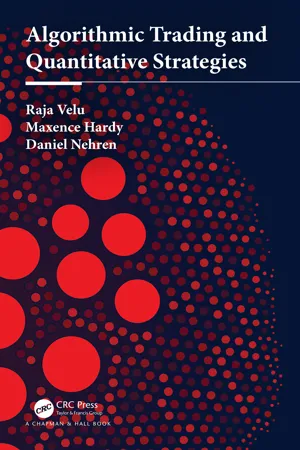1.1 A Brief History of Stock Trading
Why We Trade: Companies need capital to operate and expand their businesses. To raise capital, they can either borrow money then pay it back over time with interest, or they can sell a stake (equity) in the company to an investor. As part owner of the company, the investor would then receive a portion of the profits in the form of dividends. Equity and Debt, being scarce resources, have additional intrinsic value that change over time; their prices are influenced by factors related to the performance of the company, existing market conditions and in particular, the future outlook of the company, the sector, the demand and supply of capital and the economy as a whole. For instance, if interest rates charged to borrow capital change, this would affect the value of existing debt since its returns would be compared to the returns of similar products/companies that offer higher/lower rates of return. When we discuss trading in this book we refer to the act of buying and selling debt or equity (as well as other types of instruments) of various companies and institutions among investors who have different views of their intrinsic value.
These secondary market transactions via trading exchanges also serve the purpose of “price discovery” (O’Hara (2003) [275]). Buyers and sellers meet and agree on a price to exchange a security. When that transaction is made public, it in turn informs other potential buyers and sellers of the most recent market valuation of the security.
The evolution of the trading process over the last 200 years makes for an incredible tale of ingenuity, fierce competition and adept technology. To a large extent, it continues to be driven by the positive (and at times not so positive) forces of making profit, creating over time a highly complex, and amazingly efficient mechanism, for evaluating the real value of a company.
The Origins of Equity Trading: The tale begins on May 17, 1792 when a group of 24 brokers signed the Buttonwood Agreement. This bound the group to trade only with each other under specific rules. This agreement marked the birth of the New York Stock Exchange (NYSE). While the NYSE is not the oldest Stock Exchange in the world,1 nor the oldest in the US,2 it is without a question the most historically important and undisputed symbol of all financial markets. Thus in our opinion, it is the most suitable place to start our discussion. The NYSE soon after moved their operations to the nearby Tontine Coffee House and subsequently to various other locations around the Wall Street area before settling in the current location on the corner of Wall St. and Broad St. in 1865.
For the next almost 200 years, stock exchanges evolved in complexity and in scope. They, however, conceptually remained unchanged, functioning as physical locations where traders and stockbrokers met in person to buy and sell securities. Most of the exchanges settled on an interaction system called Open Outcry where new orders were communicated to the floor via hand signals and with a Market Maker facilitating the transactions often stepping in to provide short term liquidity. The advent of the telegraph and subsequently the telephone had dramatic effects in accelerating the trading process and the dissemination of information, while leaving the fundamental process of trading untouched.
Electronification and the Start of Fragmentation: Changes came in the late 1960s and early 1970s. In 1971, the NASDAQ Stock Exchange launched as a completely electronic system. Initially started as a quotation site, it soon turned into a full exchange, quickly becoming the second largest US exchange by market capitalization. In the meantime, another innovation was underway. In 1969, the Institutional Networks Corporation launched Instinet, a computerized link between banks, mutual fund companies, insurance companies so that they could trade with each other with immediacy, completely bypassing the NYSE. Instinet was the first example of an Electronic Communication Network (ECN), an alternative approach to trading that grew in popularity in the 80s and 90s with the launch of other notable venues like Archipelago and Island ECNs.
This evolution started a trend (Liquidity Fragmentation) in market structure that grew over time. Interest for a security is no longer centralized but rather distributed across multiple “liquidity pools.” This decentralization of liquidity created significant challenges to the traditional appr...
